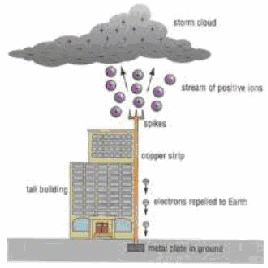Lightning is due to the generation of large voltages between clouds and the Earth during thunderstorms. Then charges are generated by friction as wind blows over the clouds and the ground. If the voltages get large enough, lightning may result. The air breaks down into ions allowing large currents to pass between the air and ground. Anything that stands above the ground – a person, tree, a building – may provide a path for the lightning to pass. Trees may be split into two down the middle, as in the novel, Jane Eyre. If the lightning strikes a person, they may well die, and if it strikes a building, structural damage may occur and electrical circuits may blow.
Buildings may be protected by means of a lightning conductor. This provides a route of low resistance that allows the large currents to pass to Earth causing little or no damage. A thick copper strip is fixed to the outside of a building, reaching above the highest point of the building, ending in several sharp spikes. The other end consists of a plate buried in the ground.

When a negatively charged thundercloud passes overhead it acts inductively on the conductor, charging the points positively and the earthed plate negatively. The negative charge on the plate is dissipated into the earth. At the same time the points – which are surrounded by large electric fields, being pointed – attract negative ions from the clouds and give up their electrons which pass down to earth. At the same time positive ions are repelled upwards from the spikes and spread out to form a 'space charge'. Any discharge which occurs will pass down the lightning conductor and pass harmlessly to earth.
